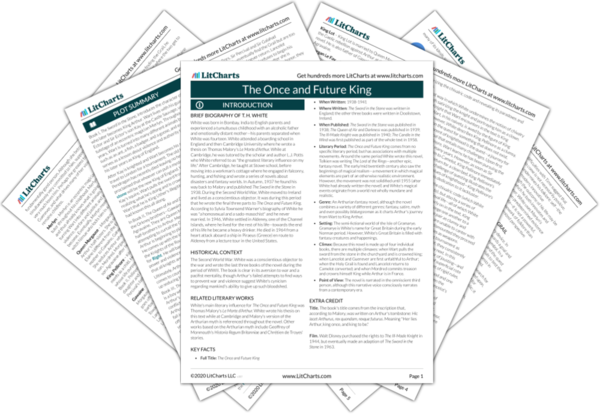Welcome to the LitCharts study guide on T. H. White's The Once and Future King. Created by the original team behind SparkNotes, LitCharts are the world's best literature guides.
The Once and Future King: Introduction
A concise biography of T. H. White plus historical and literary context for The Once and Future King.
The Once and Future King: Plot Summary
A quick-reference summary: The Once and Future King on a single page.
The Once and Future King: Detailed Summary & Analysis
In-depth summary and analysis of every chapter of The Once and Future King. Visual theme-tracking, too.
The Once and Future King: Themes
Explanations, analysis, and visualizations of The Once and Future King's themes.
The Once and Future King: Quotes
The Once and Future King's important quotes, sortable by theme, character, or chapter.
The Once and Future King: Characters
Description, analysis, and timelines for The Once and Future King's characters.
The Once and Future King: Symbols
Explanations of The Once and Future King's symbols, and tracking of where they appear.
The Once and Future King: Theme Wheel
An interactive data visualization of The Once and Future King's plot and themes.
Brief Biography of T. H. White
White was born in Bombay, India to English parents and experienced a tumultuous childhood with an alcoholic father and emotionally distant mother—his parents separated when White was fourteen. White attended a boarding school in England and then Cambridge University where he wrote a thesis on Thomas Malory's Le Morte d'Arthur. While at Cambridge, he was tutored by the scholar and author L.J. Potts who White referred to as "the greatest literary influence on my life." After Cambridge, he taught at Stowe school, before moving into a workman's cottage where he engaged in falconry, hunting, and fishing and wrote a series of novels about disasters and fantasy worlds. In Autumn, 1937 he found his way back to Malory and published The Sword in the Stone in 1938. During the Second World War, White moved to Ireland and lived as a conscientious objector. It was during this period that he wrote the final three parts to The Once and Future King. According to Sylvia Townsend Warner's biography of White he was "a homosexual and a sado-masochist" and he never married. In 1946, White settled in Aldeney, one of the Channel Islands, where he lived for the rest of his life—towards the end of his life he became a heavy drinker. He died in 1964 from a heart attack aboard a ship in Piraeus (Greece) en route to Aldeney from a lecture tour in the United States.
Get the entire The Once and Future King LitChart as a printable PDF.

Historical Context of The Once and Future King
The Second World War. White was a conscientious objector to the war and wrote the last three books of the novel during the period of WWII. The book is clear in its aversion to war and a pacifist mentality, though Arthur's failed attempts to find ways to prevent war and violence suggest White's cynicism regarding mankind's ability to give up such bloodshed.
Other Books Related to The Once and Future King
White's main literary influence for The Once and Future King was Thomas Malory's Le Morte d'Arthur. White wrote his thesis on this text while at Cambridge and Malory's version of the Arthurian myth is referenced throughout the novel. Other works based on the Arthurian myth include Geoffrey of Monmouth's Historia Regum Britanniae and Chrétien de Troyes' stories.
Key Facts about The Once and Future King
- Full Title: The Once and Future King
- When Written: 1938-1941
- Where Written: The Sword in the Stone was written in England; the other three books were written in Doolistown, Ireland.
- When Published: The Sword in the Stone was published in 1938; The Queen of Air and Darkness was published in 1939; The Ill-Made Knight was published in 1940; The Candle in the Wind was first published as part of the whole text in 1958.
- Literary Period: The Once and Future King comes from no specific literary period, but has associations with multiple movements. Around the same period White wrote this novel, Tolkien was writing The Lord of the Rings—another epic, fantasy novel. The early/mid twentieth century also saw the beginnings of magical realism—a movement in which magical elements are part of an otherwise realistic environment. However, the movement was not solidified until 1955 (after White had already written the novel) and White's magical events originate from a world not wholly mundane and realistic.
- Genre: An Arthurian fantasy novel, although the novel combines a variety of different genres: fantasy, satire, myth and even possibly bildungsroman as it charts Arthur's journey from Wart to King Arthur.
- Setting: The semi-fictional world of the Isle of Gramarye. Gramarye is White's name for Great Britain during the early Norman period. However, White's Great Britain is filled with fantasy creatures and happenings.
- Climax: Because this novel is made up of four individual books, there are multiple climaxes: when Wart pulls the sword from the stone in the churchyard and is crowned king; when Lancelot and Guenever are first unfaithful to Arthur; when the Holy Grail is found and Lancelot returns to Camelot converted; and when Mordred commits treason and crowns himself King while Arthur is in France.
- Point of View: The novel is narrated in the omniscient third person, although this narrative voice consciously narrates from a contemporary era.
Extra Credit for The Once and Future King
Title. The book's title comes from the inscription that, according to Malory, was written on Arthur's tombstone: Hic iacet Arthurus, rex quondam, rexque futurus. Meaning "Her lies Arthur, king once, and king to be."
Film. Walt Disney purchased the rights to The Ill-Made Knight in 1944, but eventually made an adaption of The Sword in the Stone in 1963.












